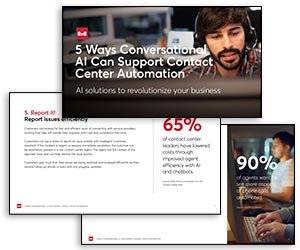8×8 explores the critical trends shaping the future of small and medium-sized businesses, from harnessing AI and enhancing customer experience to navigating cybersecurity challenges and adopting flexible work arrangements, all essential for thriving in a competitive landscape.
Smaller and growing businesses are the backbone of most economies. Globally, over 90% of all companies are classed as small and medium-sized businesses.
In the US, these make up 99.9% of American businesses, where 33,185,550 smaller businesses employ 61.7 million Americans, totalling 46.4% of private sector employees.
Importantly, they are responsible for two out of every three new jobs created in the last 25 years. In the UK, more than five million companies are classed as small or mid-sized.
The past few years have seen these businesses battle for survival in a rapidly changing economic environment. Those that made it have weathered hard times and are looking to ride the crest of key trends emerging over the coming years.
Let’s look at small business trends that will impact the fortunes of growing businesses into 2025 and beyond.
1. Artificial Intelligence
There can hardly be a list of business trends that doesn’t start with the megalith that is artificial intelligence or AI. And it’s true – the benefits of adopting AI well are significant.
According to Accenture, companies that successfully use AI to drive growth can attribute 30% of their total revenue to their AI solutions.
When you factor in improvements for businesses of all sizes across the global economy, it’s estimated that AI could add the equivalent of $2.6 trillion to $4.4 trillion every year.
2. Customer Experience
Customer Experience (CX) continues to be a key differentiator for growing businesses looking to increase their bottom line. For two cycles, 8×8 has surveyed IT and CX leaders in our CX 2030 Vision Report who have said CX will be the biggest differentiator.
This doesn’t seem to be going away, so businesses need to be ready to embrace CX enhancements to make their products, services, and brands stand out.
3. Spending
Let’s face it, money is tight for every size and type of business. For small and medium businesses, any money squandered on less-than-optimal solutions and services is money that can’t be invested in onward growth. So, it makes sense to keep a close eye on spending.
IT and communications, while absolutely essential for a growing business, are areas where overspending is commonplace. Many companies are risking significant sums on communications systems that aren’t lean, that don’t scale, and that drain resources.
4. Security
Growing businesses are a magnet for cyberattacks. Almost half of all cyber breaches happen to businesses with fewer than 1,000 employees (Strongdm 2024).
Cybercriminals see medium-sized businesses as low-hanging fruit because they don’t have the security resources that larger, established organizations have.
Smaller businesses that supply or partner with larger organizations are often seen as gateways to bigger and more lucrative targets.
So, a growing business loses money and data, as well as its reputation as a trusted partner. Around 60% of small businesses that suffer a cyberattack never recover and go out of business within six months.
5. Remote and Hybrid Working
Growing businesses are competing with larger, established organizations for the same skilled personnel. With everyone fishing in the same talent pool, smaller enterprises need to be able to differentiate their offer to recruit new staff to fuel growth. Fortunately, smaller organizations tend to be more agile and willing to adapt to new circumstances.
Increasingly, today’s employees are actively seeking remote and hybrid work. Employers that enable this suddenly find that their talent pool is much, much larger.
Communications platforms that fully address the needs of different workforces are accessible to small, medium, and large businesses alike. And what’s more, they are no longer out of the financial reach of growing businesses.
6. Employee Well-Being
Attracting and retaining an engaged, satisfied workforce is a massive priority for growing businesses. It holds the key to the ideas, dynamism, and entrepreneurial spirit that propel a business forward.
The trouble is that, in the rush to grow, too much information, too many digital communication channels, and too little structure can lead to feelings of communication overload.
This is especially true of new businesses where individuals are invested in the company’s success and truly want to help but might not be able to find the right communication methods.
Vital information can get lost, instructions duplicated, and multiple follow-ups just get annoying. The result? Communications overload, burnout and inefficiency.
The right strategies can help business owners enjoy hassle-free communications and avoid communications overload.
7. Siloed Customer Information
Siloed data and customer details presents an enormous cost to businesses. Companies can lose up to 30% in revenue annually due to inefficiencies resulting from data silos, according to IDC Market Research.
Gartner research from 2023 suggests that a company with 500 employees could potentially lose $10M in productivity every year thanks to silos. Even a fraction of that amount is a major risk to a growing business with under 500 employees.
Information silos tend to grow organically as a business develops. For rapidly growing businesses, like those moving from around 100 to 500 employees in a relatively short space of time, the problem is accelerated.
Strong, effective unified communications tools can help break down the silos between departments, increasing productivity and improving company culture and employee retention (which is good for CX too.)
8. Upgrading Tech
Technology is a perennial and constantly evolving driver for business. Growing businesses know this and are often in a better position than larger, more established organizations.
Software as a Service (SaaS) is as natural to today’s business as building massive server rooms and hefty maintenance contracts were to those starting up in the 80s, 90s, and before.
SaaS means businesses can be more agile, upgrading licenses and technology to take advantage of tech upgrades and optimize their budgets.
For example, postponing migration to the cloud not only delays productivity increases, it means continuing maintenance costs, disruption to the work environment and missing out on downstream benefits like improved collaboration, decision-making, and transformed customer experience.
And, just to bring us back to where we started, it means missing out on the artificial intelligence wave that is revolutionizing economies.
This blog post has been re-published by kind permission of 8x8 – View the Original Article
For more information about 8x8 - visit the 8x8 Website
Call Centre Helper is not responsible for the content of these guest blog posts. The opinions expressed in this article are those of the author, and do not necessarily reflect those of Call Centre Helper.
Author: 8x8
Reviewed by: Jo Robinson
Published On: 11th Oct 2024 - Last modified: 22nd Oct 2024
Read more about - Guest Blogs, 8x8






 8x8 is transforming the future of business communications as a leading Software-as-a-Service provider of voice, video, chat, contact centre, and enterprise-class API solutions, powered by one global cloud communications platform.
8x8 is transforming the future of business communications as a leading Software-as-a-Service provider of voice, video, chat, contact centre, and enterprise-class API solutions, powered by one global cloud communications platform. 









